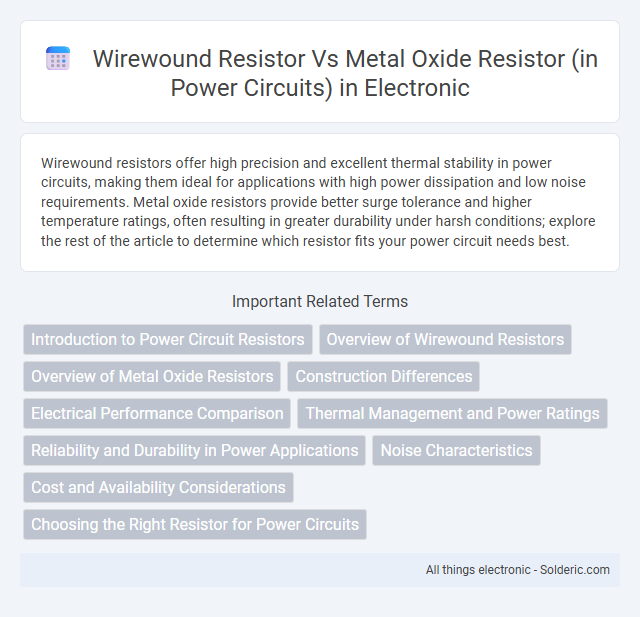Wirewound resistors offer high precision and excellent thermal stability in power circuits, making them ideal for applications with high power dissipation and low noise requirements. Metal oxide resistors provide better surge tolerance and higher temperature ratings, often resulting in greater durability under harsh conditions; explore the rest of the article to determine which resistor fits your power circuit needs best.
Comparison Table
| Feature | Wirewound Resistor | Metal Oxide Resistor |
|---|---|---|
| Construction | Wire coil wound around ceramic core | Metal oxide film deposited on ceramic base |
| Power Rating | High power handling (up to several watts) | Moderate to high power handling (commonly 1W to 10W) |
| Tolerance | Typically +-1% or better | Typically +-5% to +-1% |
| Temperature Coefficient | Low (better stability under temperature changes) | Moderate (higher resistance drift with temperature) |
| Inductance | High inductance (can affect high frequency applications) | Low inductance (better for high frequency circuits) |
| Surge Handling | Excellent surge energy absorption | Good surge capability, but less than wirewound |
| Cost | Higher cost due to complex construction | Lower cost, mass-produced |
| Applications | Power supplies, motor drives, current sensing | General power circuits, voltage dividers, protection |
Introduction to Power Circuit Resistors
Wirewound resistors offer high power dissipation and excellent stability, making them ideal for applications requiring precise current regulation and heat tolerance in power circuits. Metal oxide resistors provide better surge resistance and higher temperature ratings, ensuring reliability under transient conditions and harsh environments. Choosing between them depends on the specific power handling, thermal performance, and durability requirements of the power circuit design.
Overview of Wirewound Resistors
Wirewound resistors feature a core made of ceramic or fiberglass wound with a precise metal wire, offering high power dissipation and excellent stability in power circuits. They provide superior accuracy, low noise, and the ability to handle high surge currents, making them ideal for applications requiring reliable current limiting and voltage division. Compared to metal oxide resistors, wirewound types excel in thermal performance and longevity under heavy loads.
Overview of Metal Oxide Resistors
Metal oxide resistors in power circuits are known for their high stability, excellent surge voltage resistance, and ability to operate effectively at elevated temperatures up to 350degC. Unlike wirewound resistors, metal oxide resistors offer compact size and non-inductive characteristics, making them ideal for high-frequency applications and reducing electromagnetic interference in your designs. Their ceramic substrate and metal oxide film combine to provide enhanced reliability and longer lifespan under harsh electrical conditions.
Construction Differences
Wirewound resistors in power circuits consist of a metal wire, often nichrome, tightly wound around a ceramic or fiberglass core, offering high precision and stability under heavy loads. Metal oxide resistors feature a resistive film of metal oxides deposited on a ceramic substrate, providing excellent thermal dissipation and corrosion resistance. Understanding these construction differences helps you choose the right resistor for efficiency and durability in your power applications.
Electrical Performance Comparison
Wirewound resistors exhibit superior power dissipation and precision, making them ideal for high-current applications with low noise and stable resistance under varying temperatures. Metal oxide resistors offer high voltage tolerance, better overload capability, and enhanced resistance to thermal shock, suitable for transient-heavy power circuits. Your choice depends on specific electrical performance needs such as tolerance, thermal stability, and power rating requirements.
Thermal Management and Power Ratings
Wirewound resistors offer superior thermal management and higher power ratings due to their construction with metal wire coils, enabling efficient heat dissipation in power circuits. Metal oxide resistors provide good thermal stability and moderate power ratings but typically handle heat less effectively compared to wirewound types. For your power circuit applications requiring high reliability and heat tolerance, wirewound resistors are generally more suitable.
Reliability and Durability in Power Applications
Wirewound resistors offer superior reliability and durability in power circuits due to their ability to handle high power dissipation and maintain stable resistance under thermal stress. Metal oxide resistors provide good performance with moderate power ratings but may degrade faster in extreme temperature or overload conditions compared to wirewound types. Choosing a wirewound resistor can enhance the longevity and consistent performance of your power application, especially in demanding environments.
Noise Characteristics
Wirewound resistors exhibit lower noise levels due to their precision winding and stable inductive properties, making them ideal for sensitive power circuit applications requiring minimal signal interference. Metal oxide resistors generate moderate noise but offer superior heat dissipation and surge resistance, which benefits circuits with higher thermal stress. Your choice depends on balancing low-noise performance with thermal and voltage handling needs in power electronics design.
Cost and Availability Considerations
Wirewound resistors generally cost more than metal oxide resistors due to their complex manufacturing process and use of precision materials, impacting budget constraints in power circuit design. Metal oxide resistors are widely available and manufactured in large quantities, offering a cost-effective solution with good thermal stability and reliability. When considering cost and availability, metal oxide resistors provide a more economical option for bulk procurement, while wirewound resistors are preferred for applications requiring high precision and power handling despite higher expenses.
Choosing the Right Resistor for Power Circuits
Wirewound resistors offer high power dissipation, precise resistance values, and excellent thermal stability, making them ideal for heavy-duty power circuits requiring reliable performance under high current and temperature. Metal oxide resistors provide better surge tolerance, non-inductive properties, and greater resistance to environmental factors, suitable for circuits where transient voltage spikes and heat resistance are critical. Selecting the right resistor depends on balancing power rating, thermal management, environmental conditions, and circuit sensitivity to inductance.
wirewound resistor vs metal oxide resistor (in power circuits) Infographic

 solderic.com
solderic.com